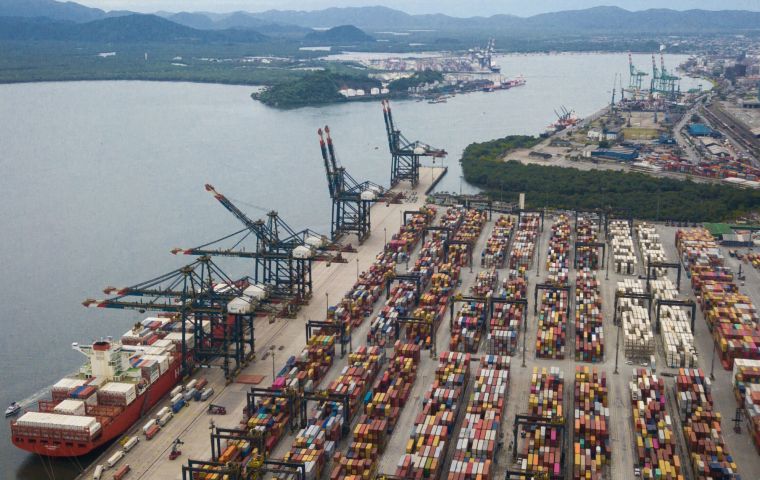MercoPress. South Atlantic News Agency
FTA to represent 5.1% increase in Brazil's commerce with EU
 The results will be seen by 2044, it was explained
The results will be seen by 2044, it was explained A Brazilian expert foresees that the Free Trade Agreement (FTA) between the Southern Common Market (Mercosur) and the European Union (EU) will represent a 5.1% increase in commerce with the bloc that is already South America's largest country's second-largest partner, behind China, Agencia Brasil reported. These projections would mean a 0.34% rise in the Gross Domestic Product (GDP), the sum of goods and services produced in the country.
As the reduction in import tariffs is gradual, the impact estimated by the economic team is for the year 2044. In 2023, trade between Brazil and the European bloc represented 16% of Brazil's foreign trade.
Professor Giorgio Romano Schutte, a member of the Observatory of Brazil's Foreign Policy and International Insertion (Opeb), said that the current agreement is better than the one negotiated in 2019, among other reasons, because of safeguards for the automotive sector, to prevent imports of European cars from damaging Brazil's industry. “But that will depend on the government on duty, whether or not it will use the safeguard power,” he said.
A professor of international relations at the Federal University of the ABC in São Paulo (UFABC), he pondered that the economic impacts of the agreement would take time to be felt and would be limited. He pointed out that only China has a trade flow with Brazil greater than the 27 countries of the European Union plus the United States.
“The impact is not that quick. It will take time for jobs to be created. But with this agreement, you increase trade. What's more, the agreement increases our negotiating power with China and the United States. There is also a political element to this agreement, in addition to the economic one. Now, a few Brazilian and Mercosur companies will certainly be able to take advantage of it to do business in the European Union,” Romano added.
The Brazilian government also estimates an increase in investments in Brazil, which represents a growth of 0.76%. A 0.56% reduction in consumer prices and a 0.42% increase in real wages are also expected. All just for 2044, he insisted.
The reduction in tariffs that Mercosur charges the EU can take place immediately or gradually from 4 to 15 years. For the automotive sector, the tariff reduction periods are longer, ranging from 18 years to 30 years for electrified, hydrogen-powered, and new technology vehicles. On the EU side, tariff reductions can also be immediate or for periods ranging from 4 years to 12 years, depending on the product, it was explained.
Quotas are also planned for Brazilian agricultural and agro-industrial products. In other words, above a certain quantity, some products start paying the full tariff to enter the bloc. These include pork, ethanol, sugar, rice, honey, corn, sorghum, and cheese, among other products.
For Professor Romano this is the main asymmetry in the agreement. “In the case of industrial products from the European Union, they enter without quotas, without restrictions on volume. In the case of agricultural products from Mercosur, there are quotas,” he said.
Brazil exported US$ 46.3 billion to the European Union in 2023: Animal feed - 11.6%; Metal ores and scrap - 9.8%; Coffee, tea, cocoa, spices - 7.8%; Seeds and oleaginous fruits - 6.4%; Iron and steel - 4.6%; Vegetables and fruit - 4.5%; Cellulose and waste paper - 3.4%; Meat and meat preparations - 2.5%; Tobacco and tobacco products - 2.2%.
Brazil imported US$ 45.4 billion from the European Union in 2023: Pharmaceutical and medicinal products - 14.7%; General machinery and industrial equipment - 9.9%; Road vehicles - 8.2%; Petroleum and petroleum products - 6.8%; Power generation machinery and equipment - 6.1%; Organic chemical products - 5.5%; Specialized machinery and equipment for certain industries - 5.3%; Electrical machinery and apparatus - 4.7%; Materials and chemical products - 3.6%; Iron and steel - 3.4%.




Top Comments
Disclaimer & comment rulesCommenting for this story is now closed.
If you have a Facebook account, become a fan and comment on our Facebook Page!